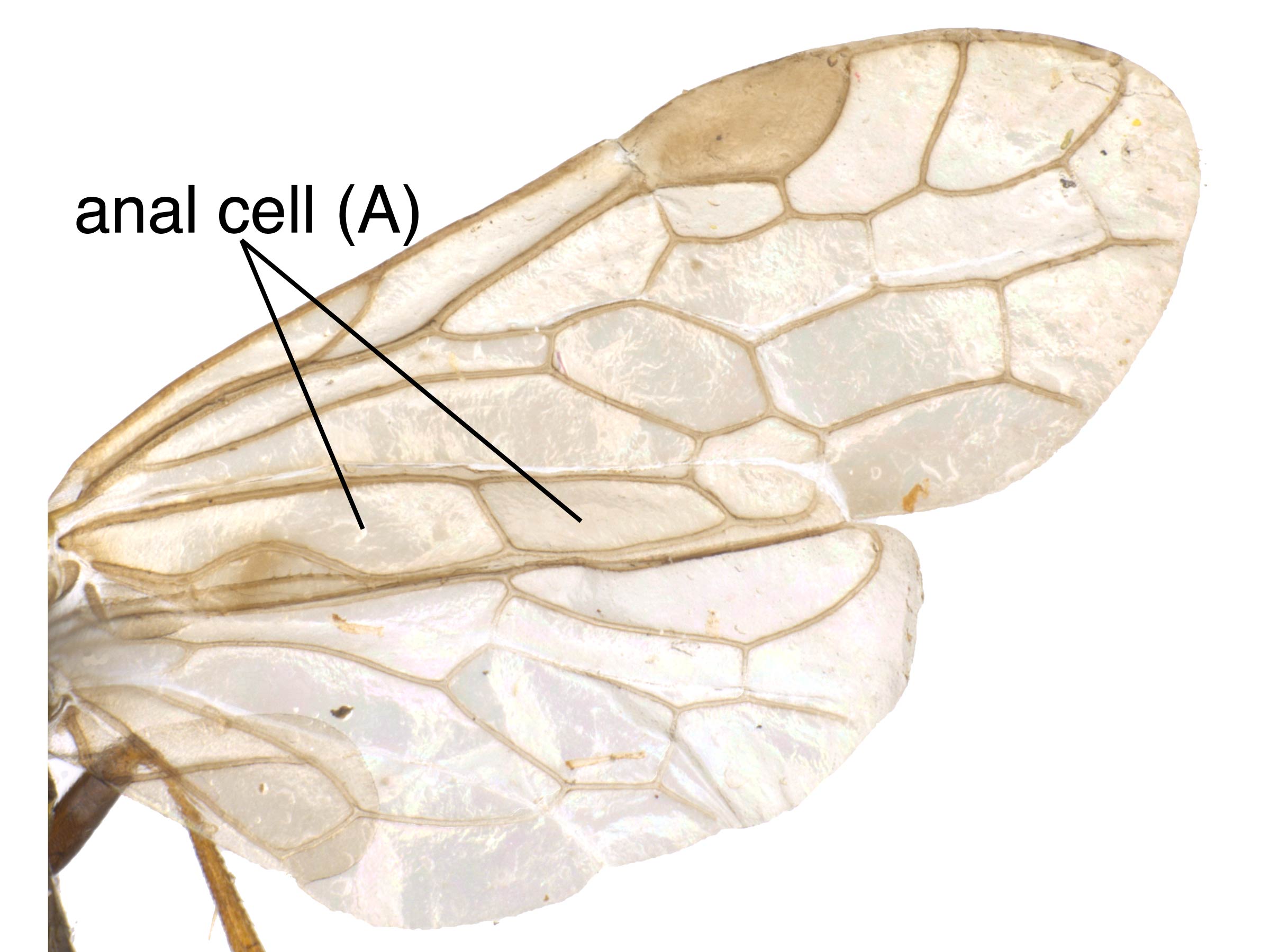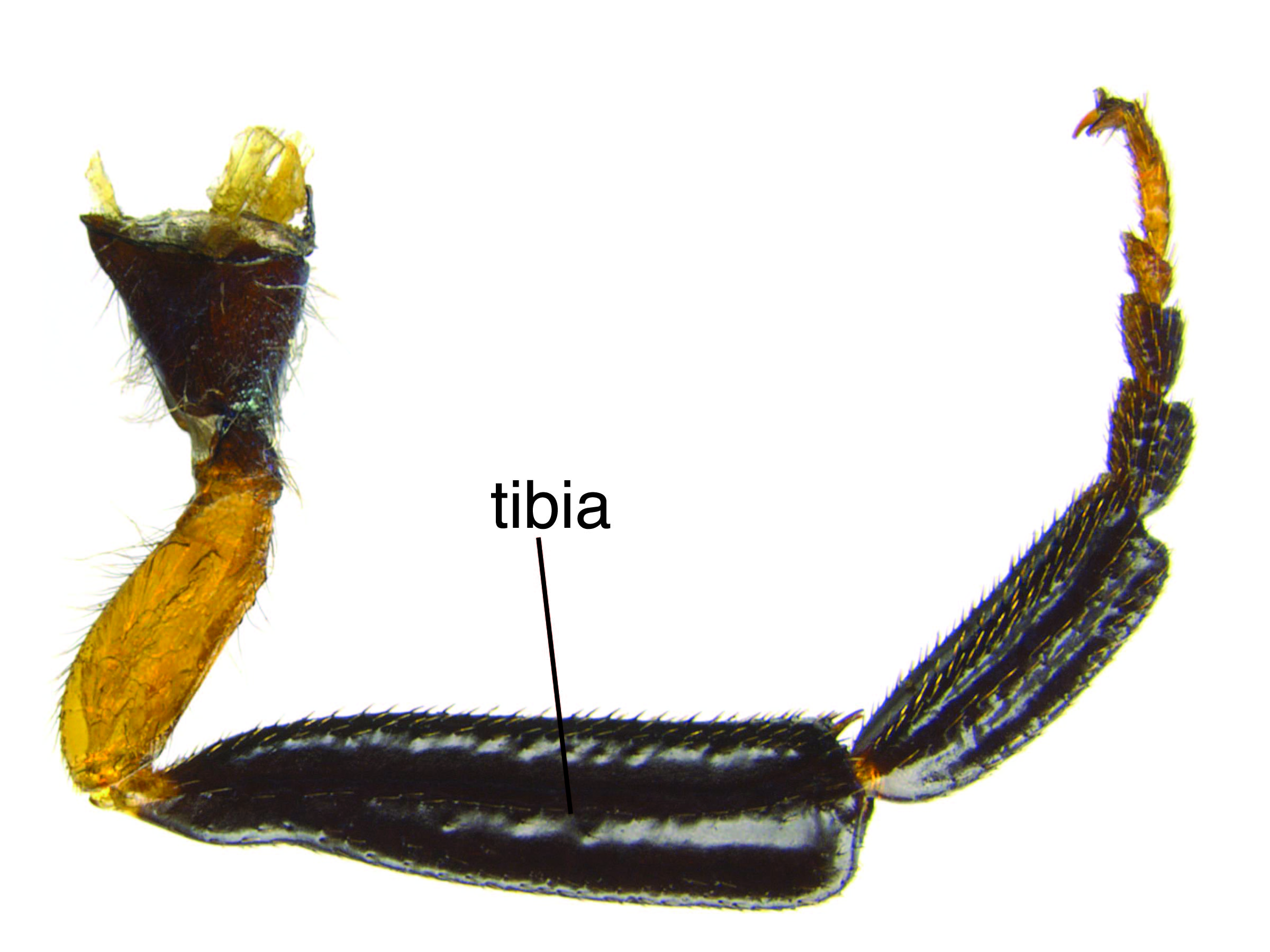Family: Tenthredinidae
Family common name: common sawflies
Subfamily: Heterarthrinae
Tribe: Fenusini
Genus: Fenella Westwood, 1839
Subgenera: none
The Tenthredinidae are the most species-rich family and are found throughout the world, in all continents but Antarctica. They are known as the “common sawflies”. They can generally be recognized by a cylindrical body and long, segmented antennaeantenna:
the sensory organ emerging from the front of the head, usually between the compound eyes and above the clypeus; includes the flagellum, scape and pedicel
 . Otherwise they come in a variety of colors, size and form (Goulet 1992Goulet 1992:
. Otherwise they come in a variety of colors, size and form (Goulet 1992Goulet 1992:
Goulet H. 1992. The genera and subgenera of the sawflies of Canada and Alaska: Hymenoptera. Symphyta. The insects and arachnids of Canada. Part 20. Agriculture Canada Publication.).
Sawflies in the Heterarthrinae subfamily are generally small and dark-colored. Many species of this family are economic pests of trees and shrubs and can be characterized by their skeletonizing or leaf-mining larval feeding behaviors. Heterarthrinae adults can be distinguished from those of other subfamilies by wing venationvenation:
the network of veins on a wing
(Smith 1971aSmith 1971a:
Smith DR. 1971a. Nearctic Sawflies. III. Heterarthrinae: Adults and larvae (Hymenoptera: Tenthredinidae). Technical Bulletin, U.S. Department of Agriculture 1420: 1-84.).
Fenella is monotypicmonotypic:
describes having only one representative; ex. a genus that includes only one species
in North America. Fenella nigrita females are all black with darkened wings. The male is unknown (Smith 1971aSmith 1971a:
Smith DR. 1971a. Nearctic Sawflies. III. Heterarthrinae: Adults and larvae (Hymenoptera: Tenthredinidae). Technical Bulletin, U.S. Department of Agriculture 1420: 1-84.).
There are 11 described extantextant:
in existence; opposite of extinct
species worldwide. One species occurs in North America (Taeger et al. 2010Taeger et al. 2010:
Taeger A, Blank SM, and Liston AD. 2010. World Catalog of Symphyta (Hymenoptera). Zootaxa 2580: 1-1064.).
Subfamily characters
 M slightly constricted at apexapex:
M slightly constricted at apexapex: vein 2r present (Goulet 1992Goulet 1992:
vein 2r present (Goulet 1992Goulet 1992:Genus characters
 veins 2A and 3A curved upwards and meeting 1A (Smith 1967cSmith 1967c:
veins 2A and 3A curved upwards and meeting 1A (Smith 1967cSmith 1967c: cellcell:
cellcell: R1 open to margin (Goulet 1992Goulet 1992:
R1 open to margin (Goulet 1992Goulet 1992: anal cellanal cell:
anal cellanal cell: absent (Smith 1967cSmith 1967c:
absent (Smith 1967cSmith 1967c: about equal to the length of the fore and mid tibiatibia:
about equal to the length of the fore and mid tibiatibia: , respectively (Smith 1967cSmith 1967c:
, respectively (Smith 1967cSmith 1967c: simple (Smith 1967cSmith 1967c:
simple (Smith 1967cSmith 1967c:Fenella can be confused with other genera in the subfamily, especially similar genera Profenusa and Fenusa. It can be distinguished by the number of antennal segments, open cellcell:
1. a membranous area of the wing between veins, 2. a small cavity or closed space
 R1 of the hind winghind wing:
R1 of the hind winghind wing:
the posterior wing of each pair of wings
 , and lack of a completely haired mesonotummesonotum:
, and lack of a completely haired mesonotummesonotum:
the second segment of the dorsum of the thorax
 (Goulet 1992Goulet 1992:
(Goulet 1992Goulet 1992:
Goulet H. 1992. The genera and subgenera of the sawflies of Canada and Alaska: Hymenoptera. Symphyta. The insects and arachnids of Canada. Part 20. Agriculture Canada Publication.).
none
Fenella nigrita in North America feeds on Potentilla (cinquefoil) (Smith 1971aSmith 1971a:
Smith DR. 1971a. Nearctic Sawflies. III. Heterarthrinae: Adults and larvae (Hymenoptera: Tenthredinidae). Technical Bulletin, U.S. Department of Agriculture 1420: 1-84.).
The specific biology of F. nigrita is unknown. LarvaeLarva:
the immature stage of holometabolous insects
 are leaf miners (Smith 1971aSmith 1971a:
are leaf miners (Smith 1971aSmith 1971a:
Smith DR. 1971a. Nearctic Sawflies. III. Heterarthrinae: Adults and larvae (Hymenoptera: Tenthredinidae). Technical Bulletin, U.S. Department of Agriculture 1420: 1-84.).
World: This genus is known from North America, Europe, North Africa, western Asia, eastern Siberia, Mongolia, Japan, and Korea (Zombori 1978Zombori 1978:
Zombori L. 1978. New sawfly species from Korea (Hymenoptera: Symphyta). Acta Zoologica Academiae Scientiarum Hungaricae 24 (1-2): 253-268., Taeger et al. 2018Taeger et al. 2018:
Taeger A, Liston AD, Prous M, Groll EK, Gehroldt T, and Blank SM. 2018. ECatSymmdash;Electronic World Catalog of Symphyta (Insecta, Hymenoptera). Program version 5.0 (19 Dec 2018), data version 40 (23 Sep 2018). Senckenberg Deutsches Entomologisches Institut (SDEI), Muuml;ncheberg. https://sdei.de/ecatsym/ Accessed: 28 Jan 2020.)
North America: Fenella nigrita is an introduced species from Europe that was first discovered in North America in Ottawa, Ontario. It now occurs in northeastern states and eastern provinces, as far west as Michigan (Smith 1971aSmith 1971a:
Smith DR. 1971a. Nearctic Sawflies. III. Heterarthrinae: Adults and larvae (Hymenoptera: Tenthredinidae). Technical Bulletin, U.S. Department of Agriculture 1420: 1-84.).
Map data from: GBIF.org (29 October 2019) GBIF Occurrence Download Fenella and the Smithsonian National Museum of Natural History Entomology Collection (USNM)
Details about data used for maps can be found here.